|
|
Also see Nest ID Matrix (contents) and Egg ID Matrix (color, spots, etc.)
To see other cavity nester bios/photos:
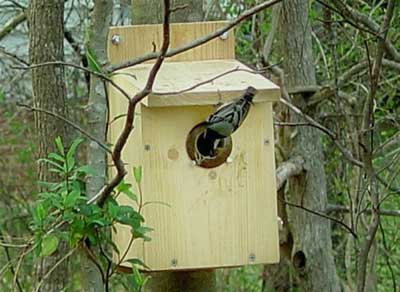 White-breasted nuthatches (WBNU) nested in this box belonging to Paul Murray. WBNU’s usually prefer to nest in natural or woodpecker cavities in large trees. White-breasted nuthatches (WBNU) nested in this box belonging to Paul Murray. WBNU’s usually prefer to nest in natural or woodpecker cavities in large trees.
|
||
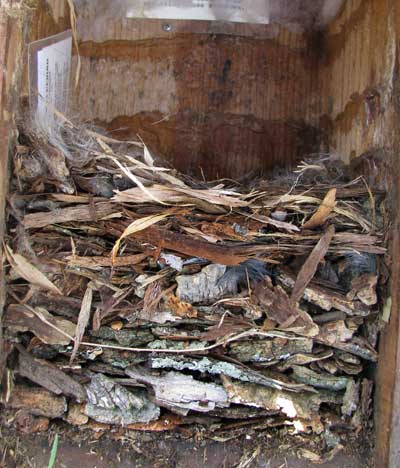 WBNU nest. Notice bark and fur. This nest is in a large, 2-hole mansion. WBNU nest. Notice bark and fur. This nest is in a large, 2-hole mansion.
Nest description: nest base may be about 1/2″ of bark (flakes and strips) and pellets of dried earth or lumps of mud. Matted nest of bark shreds, small twigs, grasses, rootlets, with a little fur, hair, feathers, cellophane, cigarette butts. Cup may be saucer shaped. |
||
| Photo below is a closeup of the top of the nest. Lots of fur. | ||
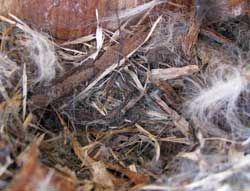 |
||
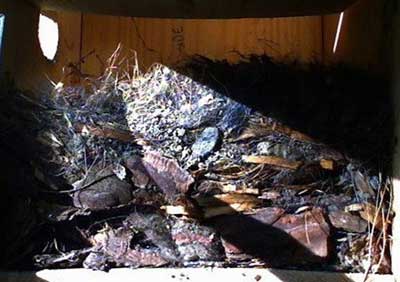 WBNU nest in box above. Photo by Paul Murray. Photo below in a different box, by Bet Zimmerman. WBNU nest in box above. Photo by Paul Murray. Photo below in a different box, by Bet Zimmerman. |
||
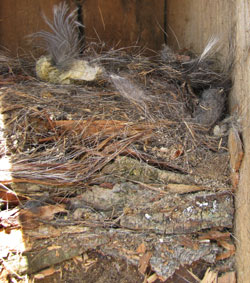 |
||
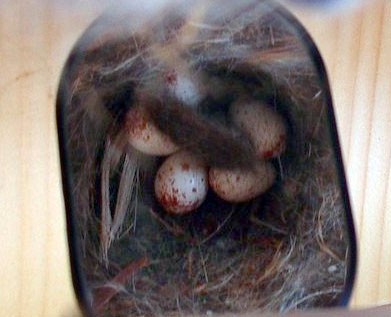 WBNU eggs. Photo by Paul Murray. WBNU eggs. Photo by Paul Murray.
Egg description: Shell smooth, very little gloss, white (can be creamy or pinkish-white), usually heavily marked with light cinnamon brown/red/ lavender/gray speckles and spots, often denser at larger end. Subelliptical to short subelliptical. |
||
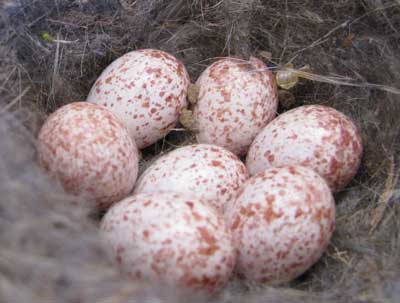 WBNU eggs in hanging box on Hill trail. Photo by Bet Zimmerman. WBNU eggs in hanging box on Hill trail. Photo by Bet Zimmerman. |
||
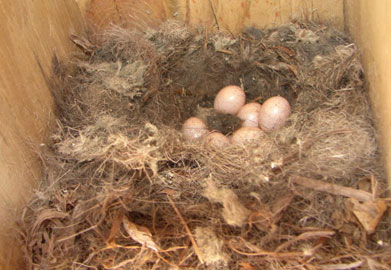 WBNU eggs. Photo to left and below by Zell Lundberg in Coaldale, CO (different nests). These eggs are less heavily spotted than the ones above. WBNU eggs. Photo to left and below by Zell Lundberg in Coaldale, CO (different nests). These eggs are less heavily spotted than the ones above. |
||
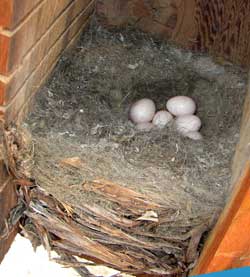 |
||
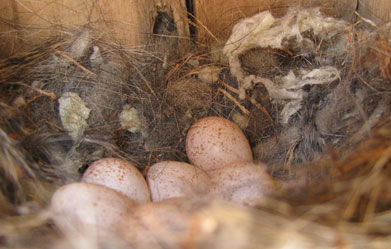 WBNU eggs in a different nest in Woodstock, CT. See side view of nest below. This nest is in a regular NABS style box mounted on a tree. WBNU eggs in a different nest in Woodstock, CT. See side view of nest below. This nest is in a regular NABS style box mounted on a tree. |
||
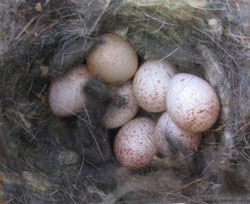 |
||
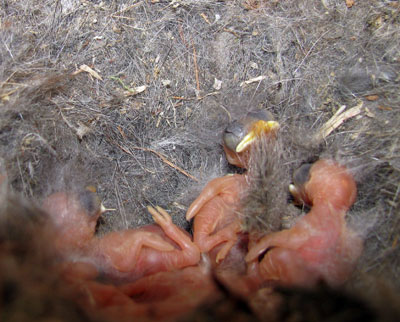 WBNU nestlings – may have just hatched (female was brooding.) Photo by Bet Zimmerman. WBNU nestlings – may have just hatched (female was brooding.) Photo by Bet Zimmerman. |
||
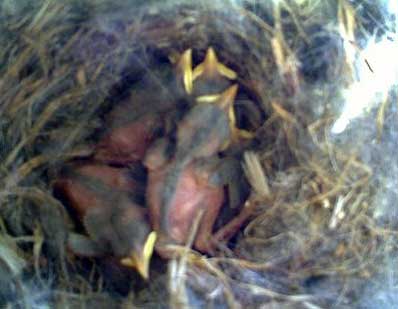 Left: Young WBNU nestlings by Murray. Notice the long legs. Below: Photo by Zell Lundberg, 2 beaks visible (there were 4 eggs) – maybe 3-4 days old. Left: Young WBNU nestlings by Murray. Notice the long legs. Below: Photo by Zell Lundberg, 2 beaks visible (there were 4 eggs) – maybe 3-4 days old. |
||
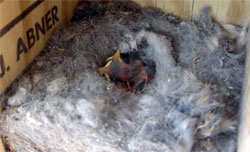 |
||
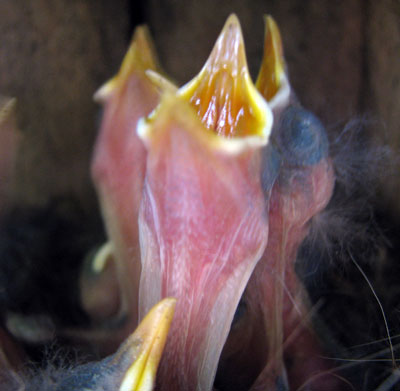 WBNU nestlings, age uncertain (eyes are not open). Unbelievable stretch. Below, same nestlings hunkered down. Photos by Bet Zimmerman. WBNU nestlings, age uncertain (eyes are not open). Unbelievable stretch. Below, same nestlings hunkered down. Photos by Bet Zimmerman. |
||
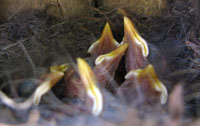 |
||
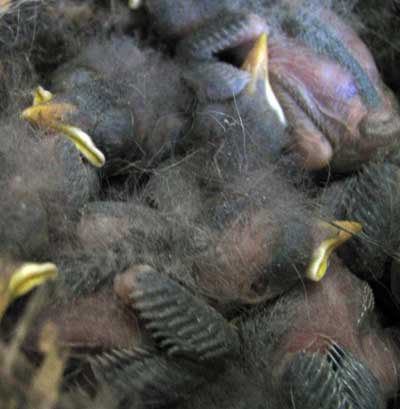 About a week old. Photo by Bet Zimmerman. About a week old. Photo by Bet Zimmerman. |
||
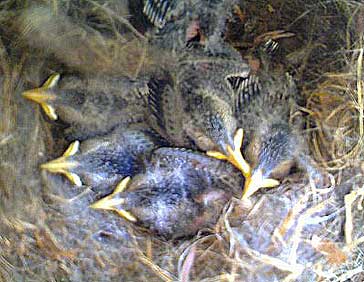 11 days old. Photo by Murray. The black cap is starting to be visible. 11 days old. Photo by Murray. The black cap is starting to be visible. |
||
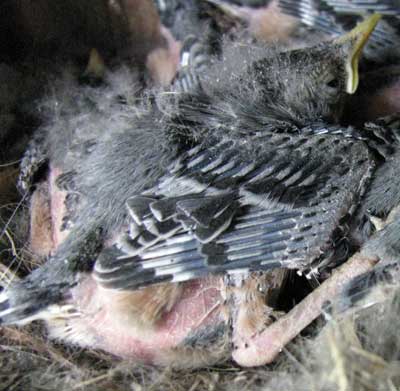 NOT an attractive stage. Photo by Bet Zimmerman. NOT an attractive stage. Photo by Bet Zimmerman. |
||
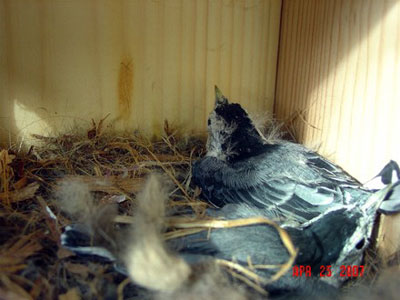 Two remaining nestlings, ready to fledge. Photo by Paul Murray. Still a little tufty up top (residual natal downy feathers that are still attached to the incoming feathers of a juvenile.) Two remaining nestlings, ready to fledge. Photo by Paul Murray. Still a little tufty up top (residual natal downy feathers that are still attached to the incoming feathers of a juvenile.) |
||
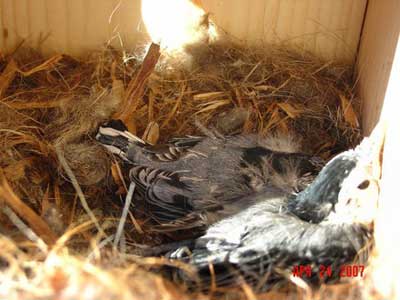 Three young had already fledged, two left. Nest materials are visible in this photo by Paul Murray. Notice short tail feathers. Three young had already fledged, two left. Nest materials are visible in this photo by Paul Murray. Notice short tail feathers. |
||
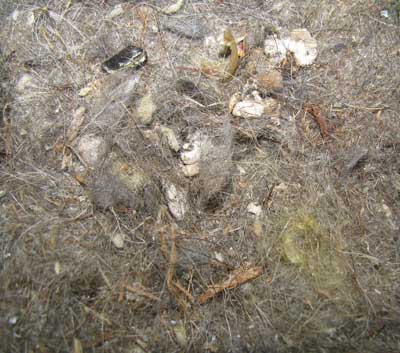 Top view of a nuthatch nest after fledging. Flat, furry, with some fecal material. Photo by Bet Zimmerman. Top view of a nuthatch nest after fledging. Flat, furry, with some fecal material. Photo by Bet Zimmerman. |
||
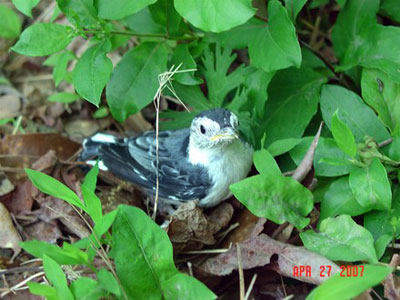 Fledgling. Photo by Paul Murray. WBNU fledglings can climb ably, but can not fly well. Their breast is whiter than an adult. Fledgling. Photo by Paul Murray. WBNU fledglings can climb ably, but can not fly well. Their breast is whiter than an adult. |
||
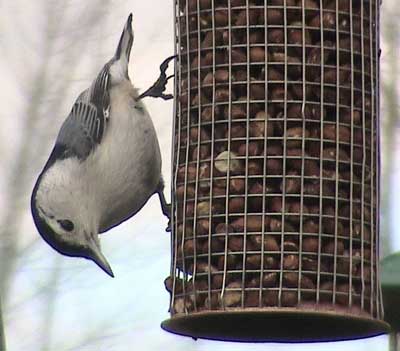 WBNU adult. Photo by John Beaudette. They are common visitors at feeders, and also enjoy suet and mealworms. WBNU adult. Photo by John Beaudette. They are common visitors at feeders, and also enjoy suet and mealworms. |
The student of Nature wonders the more and is astonished the less, the more conversant he becomes with her operations; but of all the perennial miracles she offers to his inspection, perhaps the most worthy of admiration is the development of a plant or of an animal from its embryo.
-Thomas Henry Huxley, British biologist and educator. Reflection #54, Aphorisms and Reflections, selected by Henrietta A. Huxley, Macmillan, 1907.
